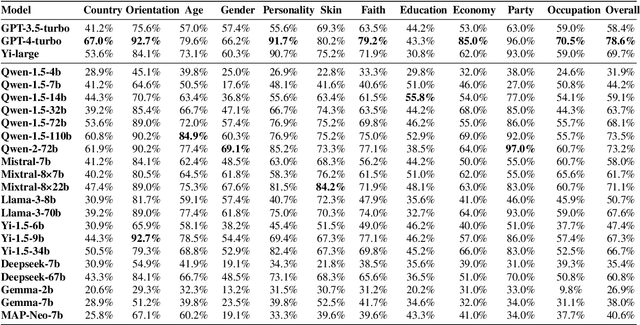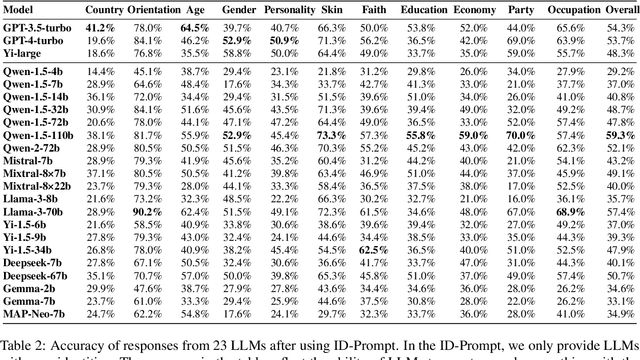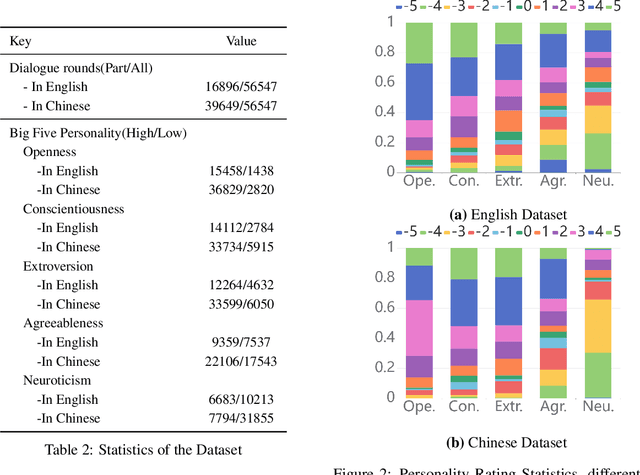Liuyu Xiang
SCOMatch: Alleviating Overtrusting in Open-set Semi-supervised Learning
Sep 26, 2024



Abstract:Open-set semi-supervised learning (OSSL) leverages practical open-set unlabeled data, comprising both in-distribution (ID) samples from seen classes and out-of-distribution (OOD) samples from unseen classes, for semi-supervised learning (SSL). Prior OSSL methods initially learned the decision boundary between ID and OOD with labeled ID data, subsequently employing self-training to refine this boundary. These methods, however, suffer from the tendency to overtrust the labeled ID data: the scarcity of labeled data caused the distribution bias between the labeled samples and the entire ID data, which misleads the decision boundary to overfit. The subsequent self-training process, based on the overfitted result, fails to rectify this problem. In this paper, we address the overtrusting issue by treating OOD samples as an additional class, forming a new SSL process. Specifically, we propose SCOMatch, a novel OSSL method that 1) selects reliable OOD samples as new labeled data with an OOD memory queue and a corresponding update strategy and 2) integrates the new SSL process into the original task through our Simultaneous Close-set and Open-set self-training. SCOMatch refines the decision boundary of ID and OOD classes across the entire dataset, thereby leading to improved results. Extensive experimental results show that SCOMatch significantly outperforms the state-of-the-art methods on various benchmarks. The effectiveness is further verified through ablation studies and visualization.
Generative Iris Prior Embedded Transformer for Iris Restoration
Jun 28, 2024Abstract:Iris restoration from complexly degraded iris images, aiming to improve iris recognition performance, is a challenging problem. Due to the complex degradation, directly training a convolutional neural network (CNN) without prior cannot yield satisfactory results. In this work, we propose a generative iris prior embedded Transformer model (Gformer), in which we build a hierarchical encoder-decoder network employing Transformer block and generative iris prior. First, we tame Transformer blocks to model long-range dependencies in target images. Second, we pretrain an iris generative adversarial network (GAN) to obtain the rich iris prior, and incorporate it into the iris restoration process with our iris feature modulator. Our experiments demonstrate that the proposed Gformer outperforms state-of-the-art methods. Besides, iris recognition performance has been significantly improved after applying Gformer.
* Our code is available at https://github.com/sawyercharlton/Gformer
GIEBench: Towards Holistic Evaluation of Group Identity-based Empathy for Large Language Models
Jun 24, 2024



Abstract:As large language models (LLMs) continue to develop and gain widespread application, the ability of LLMs to exhibit empathy towards diverse group identities and understand their perspectives is increasingly recognized as critical. Most existing benchmarks for empathy evaluation of LLMs focus primarily on universal human emotions, such as sadness and pain, often overlooking the context of individuals' group identities. To address this gap, we introduce GIEBench, a comprehensive benchmark that includes 11 identity dimensions, covering 97 group identities with a total of 999 single-choice questions related to specific group identities. GIEBench is designed to evaluate the empathy of LLMs when presented with specific group identities such as gender, age, occupation, and race, emphasizing their ability to respond from the standpoint of the identified group. This supports the ongoing development of empathetic LLM applications tailored to users with different identities. Our evaluation of 23 LLMs revealed that while these LLMs understand different identity standpoints, they fail to consistently exhibit equal empathy across these identities without explicit instructions to adopt those perspectives. This highlights the need for improved alignment of LLMs with diverse values to better accommodate the multifaceted nature of human identities. Our datasets are available at https://github.com/GIEBench/GIEBench.
From Obstacle to Opportunity: Enhancing Semi-supervised Learning with Synthetic Data
May 27, 2024



Abstract:Semi-supervised learning (SSL) can utilize unlabeled data to enhance model performance. In recent years, with increasingly powerful generative models becoming available, a large number of synthetic images have been uploaded to public image sets. Therefore, when collecting unlabeled data from these sources, the inclusion of synthetic images is inevitable. This prompts us to consider the impact of unlabeled data mixed with real and synthetic images on SSL. In this paper, we set up a new task, Real and Synthetic hybrid SSL (RS-SSL), to investigate this problem. We discover that current SSL methods are unable to fully utilize synthetic data and are sometimes negatively affected. Then, by analyzing the issues caused by synthetic images, we propose a new SSL method, RSMatch, to tackle the RS-SSL problem. Extensive experimental results show that RSMatch can better utilize the synthetic data in unlabeled images to improve the SSL performance. The effectiveness is further verified through ablation studies and visualization.
Rethinking Class-Incremental Learning from a Dynamic Imbalanced Learning Perspective
May 24, 2024



Abstract:Deep neural networks suffer from catastrophic forgetting when continually learning new concepts. In this paper, we analyze this problem from a data imbalance point of view. We argue that the imbalance between old task and new task data contributes to forgetting of the old tasks. Moreover, the increasing imbalance ratio during incremental learning further aggravates the problem. To address the dynamic imbalance issue, we propose Uniform Prototype Contrastive Learning (UPCL), where uniform and compact features are learned. Specifically, we generate a set of non-learnable uniform prototypes before each task starts. Then we assign these uniform prototypes to each class and guide the feature learning through prototype contrastive learning. We also dynamically adjust the relative margin between old and new classes so that the feature distribution will be maintained balanced and compact. Finally, we demonstrate through extensive experiments that the proposed method achieves state-of-the-art performance on several benchmark datasets including CIFAR100, ImageNet100 and TinyImageNet.
CLIP model is an Efficient Online Lifelong Learner
May 24, 2024Abstract:Online Lifelong Learning (OLL) addresses the challenge of learning from continuous and non-stationary data streams. Existing online lifelong learning methods based on image classification models often require preset conditions such as the total number of classes or maximum memory capacity, which hinders the realization of real never-ending learning and renders them impractical for real-world scenarios. In this work, we propose that vision-language models, such as Contrastive Language-Image Pretraining (CLIP), are more suitable candidates for online lifelong learning. We discover that maintaining symmetry between image and text is crucial during Parameter-Efficient Tuning (PET) for CLIP model in online lifelong learning. To this end, we introduce the Symmetric Image-Text (SIT) tuning strategy. We conduct extensive experiments on multiple lifelong learning benchmark datasets and elucidate the effectiveness of SIT through gradient analysis. Additionally, we assess the impact of lifelong learning on generalizability of CLIP and found that tuning the image encoder is beneficial for lifelong learning, while tuning the text encoder aids in zero-shot learning.
Dynamic Generation of Personalities with Large Language Models
Apr 10, 2024



Abstract:In the realm of mimicking human deliberation, large language models (LLMs) show promising performance, thereby amplifying the importance of this research area. Deliberation is influenced by both logic and personality. However, previous studies predominantly focused on the logic of LLMs, neglecting the exploration of personality aspects. In this work, we introduce Dynamic Personality Generation (DPG), a dynamic personality generation method based on Hypernetworks. Initially, we embed the Big Five personality theory into GPT-4 to form a personality assessment machine, enabling it to evaluate characters' personality traits from dialogues automatically. We propose a new metric to assess personality generation capability based on this evaluation method. Then, we use this personality assessment machine to evaluate dialogues in script data, resulting in a personality-dialogue dataset. Finally, we fine-tune DPG on the personality-dialogue dataset. Experiments prove that DPG's personality generation capability is stronger after fine-tuning on this dataset than traditional fine-tuning methods, surpassing prompt-based GPT-4.
Debiased Novel Category Discovering and Localization
Feb 29, 2024Abstract:In recent years, object detection in deep learning has experienced rapid development. However, most existing object detection models perform well only on closed-set datasets, ignoring a large number of potential objects whose categories are not defined in the training set. These objects are often identified as background or incorrectly classified as pre-defined categories by the detectors. In this paper, we focus on the challenging problem of Novel Class Discovery and Localization (NCDL), aiming to train detectors that can detect the categories present in the training data, while also actively discover, localize, and cluster new categories. We analyze existing NCDL methods and identify the core issue: object detectors tend to be biased towards seen objects, and this leads to the neglect of unseen targets. To address this issue, we first propose an Debiased Region Mining (DRM) approach that combines class-agnostic Region Proposal Network (RPN) and class-aware RPN in a complementary manner. Additionally, we suggest to improve the representation network through semi-supervised contrastive learning by leveraging unlabeled data. Finally, we adopt a simple and efficient mini-batch K-means clustering method for novel class discovery. We conduct extensive experiments on the NCDL benchmark, and the results demonstrate that the proposed DRM approach significantly outperforms previous methods, establishing a new state-of-the-art.
Read to Play (R2-Play): Decision Transformer with Multimodal Game Instruction
Feb 08, 2024Abstract:Developing a generalist agent is a longstanding objective in artificial intelligence. Previous efforts utilizing extensive offline datasets from various tasks demonstrate remarkable performance in multitasking scenarios within Reinforcement Learning. However, these works encounter challenges in extending their capabilities to new tasks. Recent approaches integrate textual guidance or visual trajectory into decision networks to provide task-specific contextual cues, representing a promising direction. However, it is observed that relying solely on textual guidance or visual trajectory is insufficient for accurately conveying the contextual information of tasks. This paper explores enhanced forms of task guidance for agents, enabling them to comprehend gameplay instructions, thereby facilitating a "read-to-play" capability. Drawing inspiration from the success of multimodal instruction tuning in visual tasks, we treat the visual-based RL task as a long-horizon vision task and construct a set of multimodal game instructions to incorporate instruction tuning into a decision transformer. Experimental results demonstrate that incorporating multimodal game instructions significantly enhances the decision transformer's multitasking and generalization capabilities.
Deep Reinforcement Learning with Multitask Episodic Memory Based on Task-Conditioned Hypernetwork
Jun 21, 2023Abstract:Deep reinforcement learning algorithms are usually impeded by sampling inefficiency, heavily depending on multiple interactions with the environment to acquire accurate decision-making capabilities. In contrast, humans seem to rely on their hippocampus to retrieve relevant information from past experiences of relevant tasks, which guides their decision-making when learning a new task, rather than exclusively depending on environmental interactions. Nevertheless, designing a hippocampus-like module for an agent to incorporate past experiences into established reinforcement learning algorithms presents two challenges. The first challenge involves selecting the most relevant past experiences for the current task, and the second is integrating such experiences into the decision network. To address these challenges, we propose a novel algorithm that utilizes a retrieval network based on a task-conditioned hypernetwork, which adapts the retrieval network's parameters depending on the task. At the same time, a dynamic modification mechanism enhances the collaborative efforts between the retrieval and decision networks. We evaluate the proposed algorithm on the challenging MiniGrid environment. The experimental results demonstrate that our proposed method significantly outperforms strong baselines.
 Add to Chrome
Add to Chrome Add to Firefox
Add to Firefox Add to Edge
Add to Edge